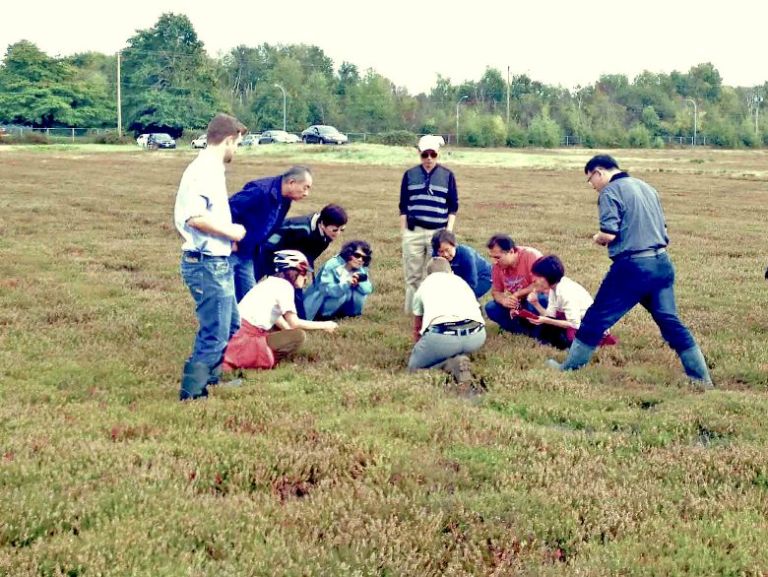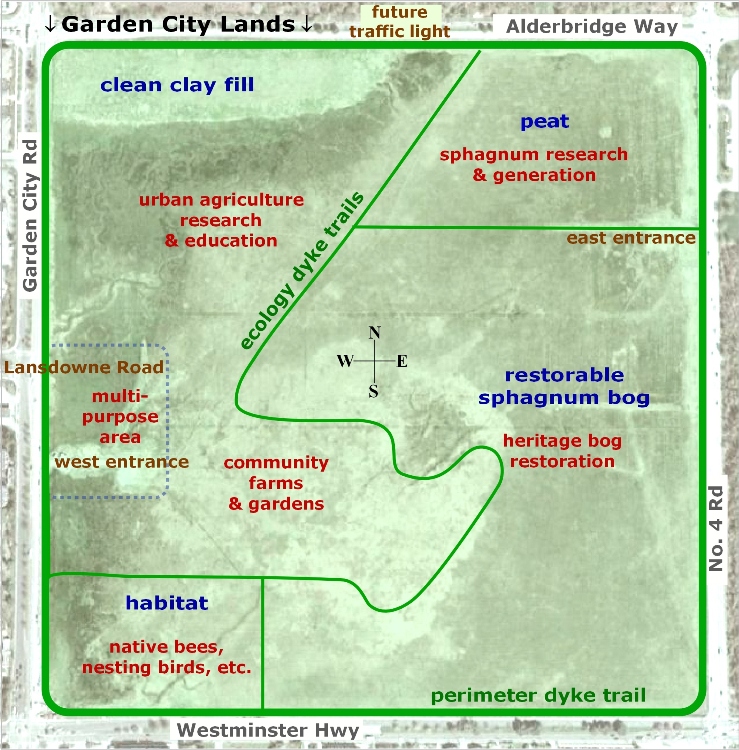
Michael Wolfe crouches to discuss low-lying cloudberries on an eco-tour
of the Garden City Lands.
| Home | Answers | Future | Action | About Us |
|
The most recent eco-tour was on Sunday, Sept. 25, 2016, from the EAST Entrance to the Garden City Lands on No. 4 Road. We'll leave the tour info until the next one is announced, but below is a photo from the recent eco-tour.
___________________ There is no charge, as it is a community service of the Garden City Conservation Society. Please be there early (on time). The tour is planned for 90 minutes (from 2:00 to 3:30), but it's okay to depart earlier. Scroll down for information on aspects like parking, clothing and the entrance location. You will see firsthand the vibrant life of the bog ecosystem, which is threatened and declining but still restorable. Nature always has a series of little surprises, and guide Michael Wolfe is there to put his expertise into down-to-earth interpretation in response to Nature and the participants. Two bog-life colouring sheets will be available as a take-away for children and anyone else who so chooses. Besides the "Friends in the Lulu Island Bog" one shown below, we have "Pollinating in the Lulu Island Bog." The artwork is courtesy of an art teacher who is a long-time member of the Garden City Conservation Society.
As usual, the tour will take place in a spirit of respectful gratitude for the legacy that Nature has given us. A natural effect is that you will become more sensitive to what Nature is telling us, as opposed to imposing whims on Nature. Starting Point: The tour will depart from the EAST Entrance to the park. It is on No. 4 Rd about 150 metres south of Alderbridge Way. It is useful to have looked at the map first. Parking: There is some parking space on the East Entrance driveway (but be sure not to obstruct the route of other vehicles). One can also park on Alexandra Road (north of Alderbridge). You can refer to this map (click here) or to the PARC map that appears lower on this page.
Your tour
Weather: It's useful to check the Richmond weather (click here) as the tour day approaches, but our tours are "rain or shine." (We would, however, take a thunderstorm delay if need be.) Weather conditions are one fun aspect of the different experience on each tour. How else to prepare: One could read about Community Wellness (below) or the PARC concept (below that). Community Wellness
One of the highest-impact ways to improve living places is with public
green spaces that are good for community wellness.
That term refers to the positive physical,
mental and social health of the people of an area. In
Richmond, the area that appears to have the most citizens in need of
greater community wellness is the City Centre Area. It includes the
public green space with the greatest potential to meet the need
˘w the Garden City Lands, the city's central park. PARC˘wParkland for Agriculture, Recreation, and Conservation The PARC graphic of the lands (below) is based on what nature tells us with the lands' differing soils, elevation, and ecology, among other realities. It illustrates a way of thinking, which involves paying attention to what the lands are telling us in the context of the best available expertise, the community thinking expressed in the extensive public consultation, and their status as Richmond parkland in the ALR. On tours, Michael has often referred to the PARC graphic and the surroundings to show how different parts of the lands lend themselves best to particular uses that complement each other. He is likely to include that approach again.
To a significant extent, the PARC graphic is based on Michael's observations and interpretation of the Lands. In preparation for the tour (or to partially replace the tour if you can't come), you will find it very helpful to read "Listening to the Lands = PARC (click here)" on the Richmond's Garden City Lands blog. The current City of Richmond park plan has gradually come closer to the PARC concept, but it would benefit from going much further. Nature as Michael's co-guide: Nature cultivated Lulu Island first. Michael Wolfe often points out native species that nature has nurtured on the Garden City Lands for centuries and even millennia. When humans arrived, many of those species provided them with food, warmth, and healing. We can cooperate with nature to restore the natural balance that will enable those species to thrive again. At the same time, we can help the area to regain its vigour as one of the green "lungs of the city." And much more. Reminder: Garden City Conservation evolved from the Garden City Lands Coalition and continues to be a community of people who want to steward the Garden City lands in the Agricultural Land Reserve for agricultural, ecological and open-land park uses for community wellness. We cooperate toward that goal as a public service for the citizens of Richmond, as well as the region, the province, and the world. Read more: Please read more about this on the Garden City Conservation blog. Other questions: Email GardenCityLands@shaw.ca with "Next GCL tour" in the subject line |
Copyright © 2016 Garden City Conservation Society, Richmond, B.C., Canada | Website designed by Zboya Design



